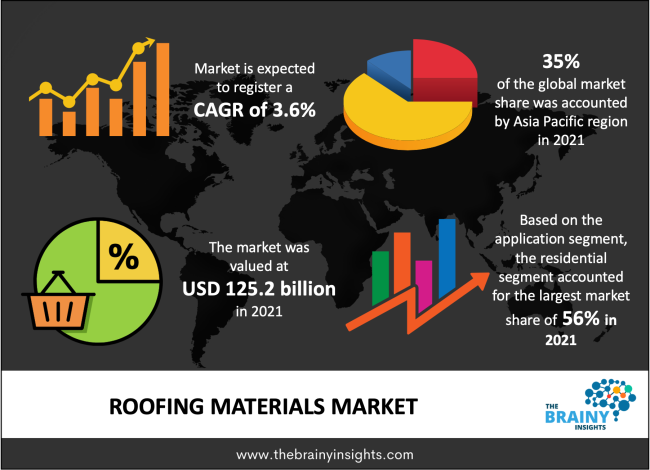
Roofing Materials Market Overview
The roofing materials market involves the production, sale, and use of materials designed to cover the roofs of buildings, providing protection from weather elements like rain, snow, wind, and sunlight. The market encompasses various types of materials, such as asphalt shingles, metal, tiles, wood, and synthetic options, each offering unique advantages in terms of durability, cost, and aesthetics.
This market has been witnessing significant growth driven by the construction industry, particularly in the residential, commercial, and industrial sectors. Increasing urbanization, growing demand for energy-efficient solutions, and advancements in roofing technology are among the key drivers.
The Roofing Materials market was valued at approximately USD 125.2 billion in 2021 and is expected to grow at a compound annual growth rate (CAGR) of about 3.6% from 2022 to 2030. By 2030, the market is projected to reach around USD 189.2 billion.
Market Dynamics
Drivers:
- Construction Growth: Rising global construction activities, particularly in emerging markets, fuel demand for roofing materials.
- Energy Efficiency: Energy-efficient roofing solutions, such as cool roofs and reflective coatings, are gaining traction due to the increasing emphasis on sustainability.
- Weather Resilience: The growing frequency of extreme weather events, like storms and heatwaves, boosts the need for more durable and resilient roofing materials.
- Technological Advancements: Innovations in materials, such as solar roofs, green roofs, and better insulation, continue to drive the market forward.
Restraints:
- High Initial Costs: The cost of high-performance materials can be a barrier for residential consumers and small businesses.
- Environmental Concerns: Some roofing materials, particularly certain plastics and asphalt products, face increasing environmental scrutiny due to their non-biodegradable nature.
Opportunities:
- Smart Roofs: The integration of IoT and sensors for monitoring and managing roofing systems offers new opportunities in smart home technology.
- Emerging Markets: Growing infrastructure development in Asia Pacific, Latin America, and Africa presents an opportunity for market expansion.
Regional Analysis
- North America: Dominates the global roofing materials market due to a strong construction industry, high consumer awareness of energy-efficient products, and cold climates that require durable roofing systems.
- Europe: The market is driven by the region's adoption of sustainable materials, including green roofs and solar tiles, in line with environmental policies.
- Asia Pacific: Witnesses the fastest growth due to rapid urbanization, infrastructural development, and increased construction activities, particularly in countries like China and India.
- Latin America and Africa: Growth is driven by urbanization and industrialization, though the market is somewhat restrained by economic factors and the affordability of roofing solutions.
Segmental Analysis
- By Material Type:
- Asphalt Shingles
- Metal Roofing
- Tiles
- Wood
- Synthetic Roofing Materials
- Green Roofing
- By Application:
- Residential
- Commercial
- Industrial
- By End-Use:
- New Construction
- Renovation and Repair
- By Region:
- North America
- Europe
- Asia Pacific
- Latin America
- Middle East & Africa
List of Key Players
- CertainTeed (Saint-Gobain)
- GAF (Standard Industries)
- Owens Corning
- Atlas Roofing Corporation
- Kingspan Group
- Braas Monier Building Group
- Tata Steel
- Johns Manville (Berkshire Hathaway)
- Icopal (BMI Group)
- Fakro
Key Trends
- Sustainable and Green Roofing: The rise in environmental consciousness is leading to a demand for sustainable and eco-friendly roofing options like green roofs and solar tiles.
- Reflective Roofing: The adoption of cool roofing solutions that reflect sunlight and absorb less heat, thus improving energy efficiency, is gaining momentum.
- Smart Roofs: The integration of roofing with smart technology, such as IoT sensors to monitor structural health and environmental conditions, is a growing trend.
Request PDF Brochure: https://www.thebrainyinsights.com/enquiry/sample-request/13156
Conclusion
The roofing materials market is evolving with innovations in technology and growing demand for sustainable solutions. As the construction industry continues to expand globally, driven by both residential and commercial projects, the need for durable, energy-efficient, and weather-resistant roofing materials will remain strong. Companies investing in green technologies and smart roofing solutions are likely to lead the market in the coming years. The regional dynamics and evolving consumer preferences present both challenges and opportunities for growth in this competitive market.
